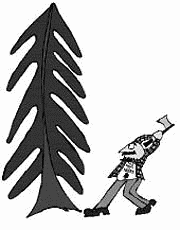SIERRA CLUB STAFFER Charlie Raines is a figure of some controversy among environmental activists, and even within his own organization. An expert on forest issues who has worked tirelessly to bring Cascades land into public ownership, Raines has also been accused of compromising too much, of cozying up to timber companies, and of being a loose cannon, among other things.
His latest initiative has ruffled a few more feathers.
As reported in a recent Seattle Weekly story (“Tree-huggin’ lumberjacks,” 6/1/00), Raines, together with a handful of other green leaders, is exploring a novel strategy to preserve forestland in the Cascade foothills: purchase the land and then selectively cut and sell off some of the trees. The idea is to pay for the land acquisition with timber revenues, thereby saving the forest from more aggressive industrial logging or conversion to condos. The strategy would only be used for lands that have already seen significant cutting and that are threatened by development.
However, the idea has not gone over well among Sierra Club higher-ups.
Immediately after the Seattle Weekly story appeared, an e-mail outcry went up among the club’s national board of directors, some of whom were aghast at the notion of the Sierra Club being tied to the logging business.
The club’s national conservation director, Bruce Hamilton, fired off a note to Michael McGinn, an official with the club’s Northwest chapter, asking for an explanation and stating, “This would require national review and approval . . . [and] is a bad idea for Club involvement.”
McGinn sent club officials an e-mail reply, characterizing the Seattle Weekly story as “misleading”: “The Cascade Chapter is most definitely not going into the logging business as a landowner, part owner of a logging company, or anything of the sort . . . the Cascade Chapter will not own, operate, or be in any way involved in logging operations,” wrote McGinn.
For the record, the Seattle Weekly story did not attempt any description of the nature and scope of the Sierra Club’s involvement, and Raines himself never raised the subject. The story clearly noted that Raines is working on this project with the Land Conservancy of Seattle and King County.
But whatever Raines’ original intentions, there is little doubt he will have to proceed with caution now and that the local Sierra Club chapter will be limited in its role. “We may be an advocate” for this new land preservation strategy, Raines says, “but we wouldn’t be a partner.”
Says Bruce Hamilton of the national Sierra Club office, in an interview: “The [Cascade] Chapter is fully authorized to encourage others to do this. But owning and managing land for resource exploitation is not something the Sierra Club wants to be engaged in.”
THE MINI-FLAREUP points to lingering tensions within the Sierra Club that have divided local chapters from headquarters staff and more moderate members from a radical insurgent wing. A continuing debate over values and strategy has left some frayed nerves, especially with regard to Raines.
Just last year, Raines was the object of a major club crackdown when the national board stepped in and demanded changes to a giant land trade between the U.S. Forest Service and Plum Creek timber company, known as the I-90 exchange, which Raines had spent years negotiating.
Raines’ willingness to trade away certain public lands in the Gifford Pinchot National Forest was opposed by the board, as well as other local greens. Another major land trade that Raines helped engineer with Weyerhauser was put on hold last year after a federal appeals court determined that the environmental consequences had not been adequately assessed.
David Orr, a Sierra Club activist in Moab, Utah, who helped lead the charge against the land trades last year, has been fanning the flames against Raines’ latest effort as well. “I was shocked that we have a Sierra Club staff person expressing unhesitating support for an operation that would depend upon logging for acquisition of land,” Orr says.
As cofounder of a more radical wing of the Sierra Club known as the John Muirs (after the club founder), Orr has been trying to push the Sierra Club toward a tougher green line. He is impatient with what he sees as a kind of Seattle-style environmentalism that he believes has become caught up in “deal-making” at the expense of “traditional forms of advocacy”—such as stricter regulations on corporations and “civil disobedience, if need be.” Orr observes, “John Muir wasn’t about compromise.”
But Raines himself believes that “all the things we’ve talked about are consistent with Sierra Club’s principles.” He notes that “being a leader in conservation sometimes leads you into new, strange areas.” Once people understand the new timber revenue strategy for land preservation, he predicts, “Most folks will see this as a legitimate tool to combat sprawl.”








